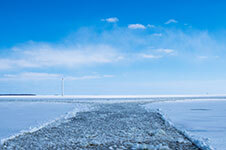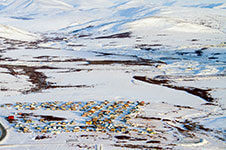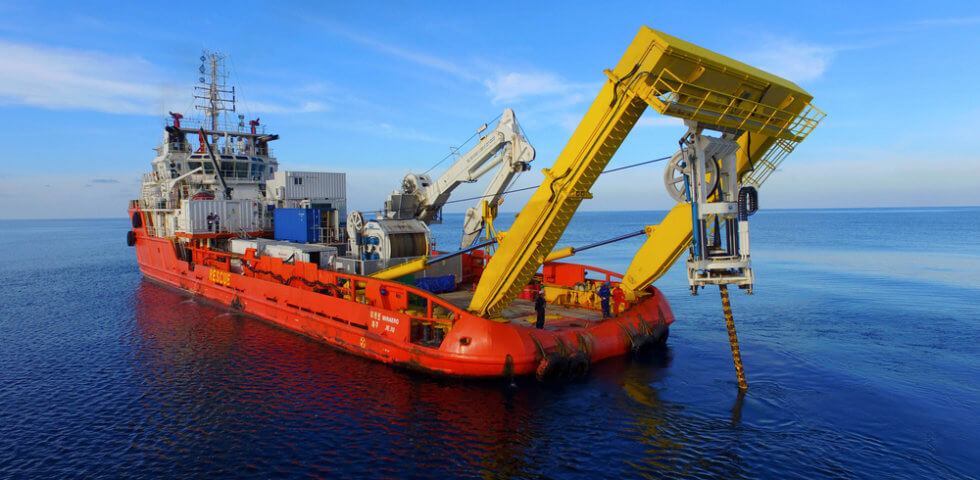While you might assume that internet infrastructure is owned and operated by local or federal governments, the internet is primarily managed by private companies. The subsea cable industry is no exception to this, and fiber optic companies, such as Quintillion, have taken on the huge task of helping connect the world.
Installing subsea cables around the globe can be incredibly challenging. And while there are countless fiber optic companies globally, that are several common problems experienced across the board. These are the same issues Quintillion faced when building the first subsea fiber optic cable system in the US Arctic, and they are challenges we continue to navigate as we expand that network to other parts of the world. Let’s take a deeper look at the five biggest issues that companies in the subsea cable industry face as we attempt to bring reliable broadband to every corner of the earth.
1) Shortages in Fiber Optics Cables
The submarine fiber optic cable industry has seen significant growth in major years, with a forecasted compound annual growth rate (CAGR) of about 13.5% until 2026. This is largely due to the immense growth of the internet. If you look back at 1995, less than 1% of the world was using the internet, which equaled about 16 million users. Today, more than 65.6% of people use the internet, which is approximately 5,168,000,000 people in the world. And these numbers will only grow as there is a push to bring broadband to even the most remote parts of the world, helping bridge the digital divide.
As the demand for internet services grows, so does the need for infrastructure to support this growth. This means, in part, expanding the world’s current fiber optic network by installing more subsea cables. However, this global movement is being slowed by a supply and demand issue. There have been major shortages in fiber cables and ODN infrastructure, which has pushed suppliers back 12 to 18 months. There also shortages in other electronic components such as flash memory, capacitors, and semiconductors.
The COVID-19 pandemic has only intensified these issues. Shutdowns in the United States and other parts of the world caused electronic manufacturing plants to halt production. The biggest issue is semiconductor chips, which are the same reason for a severe shortage in new vehicles for sale.
In addition to a physical shortage in the components needed to construct subsea cable networks, there is also a shortage of skilled workers in telecommunications. There are more open positions than there are professionals in this industry, so many companies are relying on training programs and apprenticeships to fill their growing labor needs.
2) Logistical Issues Getting Subsea Cables to Remote Locations
For remote areas like Northern Alaska, it can be difficult to transport subsea cable components to their intended destination. Unlike highly populated, industrialized areas, rural locations do require much more logistical planning for supplies to get to their remote destinations. Not only is this more difficult to accomplish, but it’s more expensive too. For Alaska, especially in the communities Quintillion serves, it is much more expensive to build out fiber optic cables networks — compared to states in the lower 48.
3) Difficulties Funding Fiber Optic Network Projects
No matter the location, building a subsea fiber optic cable network is very expensive, and finding sources for funding can be a challenge. Many fiber optic companies are privately owned, and there are several options for funding, including:
- Private investors
- Public leasing
- Federal funding
- Municipal funding
However, many companies struggle to identify who their funding stakeholders are and where they can effectively source their funding. And while there has been an increase in government funding available to help with economic development for the various types of funding and telecommunication infrastructure expansion, the eligibility criteria can be limiting in who can apply.
4) Challenges Building Subsea Cable Routes
After getting the equipment and construction supplies where they need to go, the next challenge subsea cable companies have is the actual process of planning and building the route. This process is much more simplistic in areas with flat, accessible terrain. However, when dealing with rough terrains and extreme weather conditions, it’s incredibly challenging to install terrestrial and subsea fiber optic cables.
In Alaska, this has been one of the most significant hurdles for installing fiber in rural communities. It’s not until recent years that it has been possible to install subsea cables in the Arctic regions of Alaska. However, melting sea ice along Alaska coastlines has made it possible to map out fiber optic routes. And the Quintillion network showed the world that building a subsea fiber optic cable network and bringing reliable broadband to rural Alaska communities was possible.
While each location has its own geographical challenges to address, in the Alaska Arctic we’ve had to overcome challenges such as large undersea mountain ranges, strong tidal waves, frozen winters, fault lines, and ice structures. It takes time, effort, and money to collect accurate data and precise measurements for choosing a fiber optic route.
And then comes the actual process of laying down the fiber. These cables are installed using cable ships and are buried beneath the seabed. These ships are limited in how many kilometers of cables they can hold (typically around 2000km), and it’s a tedious process to install thousands of miles of cables in the ocean. It can take a few weeks alone to load the ship, and it takes a great deal of heavy machinery and engineering to precisely lay the cables along the predetermined route. On average, engineers can lay cables at a rate between 100 and 200km a day.
5) Security and Maintenance Issues With Fiber Optic Networks
Not only are subsea cable networks hard to build, but they are also difficult to maintain. Fishing trawlers and anchors can sometimes unearth cables, and natural causes, such as earthquakes, can damage fiber optic cable systems. It is also possible for malevolent parties to tamper with or purposely damage cables. And data security is a concern for subsea cable companies, as it’s possible for adversaries to tap into cables and data systems to collect or delete sensitive information.
The most common threat to fiber optic cables are natural causes and fishing vessels, and fiber optic companies need to have a plan in place if a cable is ever damaged. Advanced monitoring systems can help companies react as quickly as possible. However, in Alaska, addressing an issue is a bigger challenge in the winter as bodies of water can freeze, making it difficult to access and repair cables.
Fiber optic cable companies must always be on standby. If cables are damaged, that results in lost or slowed internet service for consumers. Responding quickly to an infrastructure problem is critical. This means having access to engineers and cable ships that can make repairs, as well as having funds set aside to pay for repairs and maintenance when needed.
Overcoming Challenges in The Subsea Cable Industry
From creating more resilient fiber optics cables to relentlessly searching for routes where subsea cables can be laid, each day we get closer to our goal. It takes a certain level of ingenuity and tenacity to make it in the fiber optics industry, but we continue pushing onward in our mission to better our communities and connect even the most remote parts of the world to the internet.
From creating more resilient fiber optics cables to relentlessly searching for routes where subsea cables can be laid, we get closer each day to our goal. For Quintillion, building a subsea cable network in the Alaska Arctic was a major milestone in our journey. But our aspirations don’t end there. We’ll not only continue to push on with the same pioneering spirit and grit that got us this far, but we’ll also work to overcome the challenges ahead in order to serve our Alaskan community, our country, and the rest of the world.
Join us in our mission to connect with the world with fiber. Contact us to learn more.















